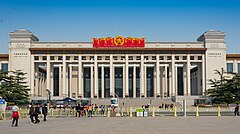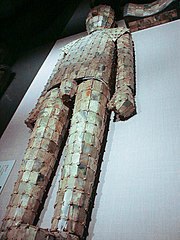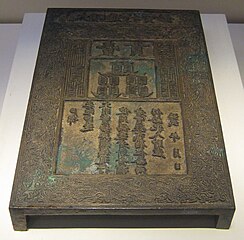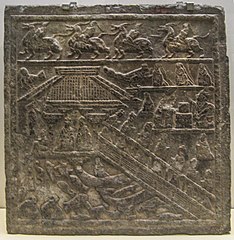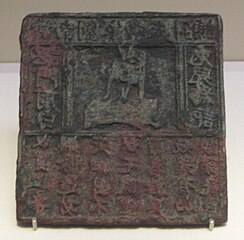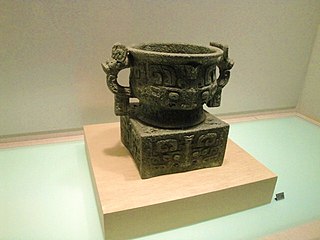
Chinese art is visual art that originated in or is practiced in China, Greater China or by Chinese artists. Art created by Chinese residing outside of China can also be considered a part of Chinese art when it is based on or draws on Chinese culture, heritage, and history. Early "Stone Age art" dates back to 10,000 BC, mostly consisting of simple pottery and sculptures. After that period, Chinese art, like Chinese history, was typically classified by the succession of ruling dynasties of Chinese emperors, most of which lasted several hundred years. The Palace Museum in Beijing and the National Palace Museum in Taipei contains extensive collections of Chinese art.

Luoyang is a city located in the confluence area of the Luo River and the Yellow River in the west of Henan province. Governed as a prefecture-level city, it borders the provincial capital of Zhengzhou to the east, Pingdingshan to the southeast, Nanyang to the south, Sanmenxia to the west, Jiyuan to the north, and Jiaozuo to the northeast. As of December 31, 2018, Luoyang had a population of 6,888,500 inhabitants with 2,751,400 people living in the built-up area made of the city's five out of six urban districts and Yanshi District, now being conurbated. By the end of 2022, Luoyang Municipality had jurisdiction over 7 municipal districts, 7 counties and 1 development zone. The permanent population is 7.079 million.

The Shanghai Museum is a municipal public museum of ancient Chinese art, situated on the People's Square in the Huangpu District of Shanghai, China. It is funded by the Shanghai Municipal Culture and Tourism Bureau.

Shaanxi History Museum, which is located to the northwest of the Giant Wild Goose Pagoda in the ancient city Xi'an, in the Shaanxi province of China, is one of the first huge state museums with modern facilities in China and one of the largest. The museum houses over 370,000 items, including murals, paintings, pottery, coins, as well as bronze, gold, and silver objects. The modern museum was built between 1983 and 2001 and its appearance recalls the architectural style of the Tang dynasty.

Yinxu is a Chinese archeological site corresponding to Yin, the final capital of the Shang dynasty. Located in present-day Anyang, Henan, Yin served as the capital during the Late Shang period which spanned the reigns of 12 Shang kings and saw the emergence of oracle bone script, the earliest known Chinese writing. The site's existence had been forgotten for millennia, along with that of oracle bone script and other material evidence of the Shang's existence. It was only rediscovered in 1899, following an investigation into oracle bones that were found being sold near the site. The rediscovery of Yinxu marked the beginning of decades of its intensive excavation and study. It is one of China's oldest and largest archeological sites, and was selected as a UNESCO World Heritage Site in 2006. Yinxu is located in northernmost Henan province near the modern city of Anyang, and near the Hebei and Shanxi province borders. Public access to the site is permitted.

Chinese bronze inscriptions, also commonly referred to as bronze script or bronzeware script, are writing in a variety of Chinese scripts on ritual bronzes such as zhōng bells and dǐng tripodal cauldrons from the Shang dynasty to the Zhou dynasty and even later. Early bronze inscriptions were almost always cast, while later inscriptions were often engraved after the bronze was cast. The bronze inscriptions are one of the earliest scripts in the Chinese family of scripts, preceded by the oracle bone script.

The zun or yi, used until the Northern Song (960–1126) is a type of Chinese ritual bronze or ceramic wine vessel with a round or square vase-like form, sometimes in the shape of an animal, first appearing in the Shang dynasty. Used in religious ceremonies to hold wine, the zun has a wide lip to facilitate pouring. Vessels have been found in the shape of a dragon, an ox, a goose, and more. One notable zun is the He zun from the Western Zhou.
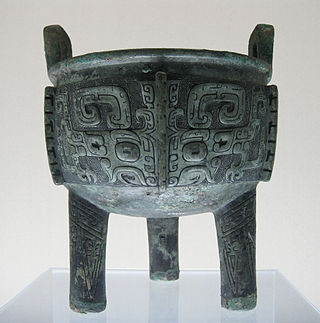
Ding are prehistoric and ancient Chinese cauldrons standing upon legs with a lid and two fancy facing handles. They are one of the most important shapes used in Chinese ritual bronzes. They were made in two shapes: round vessels with three legs and rectangular ones with four, the latter often called fāng dǐng "square ding (方鼎. They were used for cooking, storage, and ritual offerings to the gods or to ancestors.

A guang or gong is a particular shape used in Chinese art for vessels, originally made as Chinese ritual bronzes in the Shang dynasty, and sometimes later in Chinese porcelain. They are a type of ewer which was used for pouring rice wine at ritual banquets, and often deposited as grave goods in high-status burial. Examples of the shape may be described as ewers, ritual wine vessels, wine pourers and similar terms, though all of these terms are also used of a number of other shapes, especially the smaller tripod jue and the larger zun.
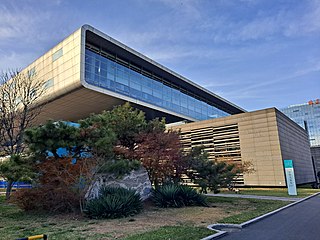
The National Library of China (NLC) is the national library of China, located in Beijing, and is one of the largest libraries in the world. It contains over 41 million items as of December 2020. It holds the largest collection of Chinese literature and historical documents in the world and covers an area of 280,000 square meters. The National Library is a public welfare institution funded by the Ministry of Culture and Tourism.

The Liaoning Provincial Museum is a prominent museum of history and fine arts located in Shenyang, the capital of China's Liaoning province.
Ancient Chinese urban planning encompasses the diverse set of cultural beliefs, social and economic structures, and technological capacities that influenced urban design in the early period of Chinese civilization. Factors that have shaped the development of Chinese urbanism include: fengshui, and astronomy; the well-field system; the cosmological belief that Heaven is round, and the Earth is square, the concept of qi ; political power shared between a ruling house and educated advisers; the holy place bo; a three-tiered economic system under state control; early writing; and the walled capital city as a diagram of political power.

A hu is a type of wine vessel that has a pear-shaped cross-section. Its body swells and flares into a narrow neck, creating S-shaped profile. While it is similar to you vessel, hu usually has a longer body and neck. The shape of hu probably derives from its ceramic prototype prior to the Shang dynasty. They usually have handles on the top or rings attached to each side of neck. Many extant hu lack lids while those excavated in such tombs as Fu Hao's indicate that this type of vessel might be originally made with lids. Although it is more often to see hu having a circular body, there also appears hu in square and flat rectangular forms, called fang hu and bian huArchived 2015-09-23 at the Wayback Machine in Chinese. In addition, hu often came to be found in a pair or in a set together with other types of vessels. As wine had played an important part in the Shang ritual, the hu vessel might be placed in the grave of an ancestor as part of ritual in order to ensure a good relationship with ancestor's spirit.

A jia is a ritual vessel type found in both pottery and bronze forms; it was used to hold libations of wine for the veneration of ancestors. It was made either with four legs or in the form of a tripod and included two pillar-like protrusions on the rim that were possibly used to suspend the vessel over heat. The earliest evidence of the Jia vessel type appears during the Neolithic Period. It was a prominent form during the Shang and early Western Zhou dynasties, but had disappeared by the mid-Western Zhou.

Luoyang Museum is a historical museum in Luoyang, Henan Province, China. Situated in the Yellow River valley. It offers exhibits of the rich cultural heritage of Luoyang, a major Chinese cultural centre, which was the capital of several Chinese dynasties including the Eastern Zhou and the Eastern Han.

A gu is a type of ancient Chinese ritual bronze vessel from the Shang and Zhou dynasties. It was used to drink wine or to offer ritual libations.
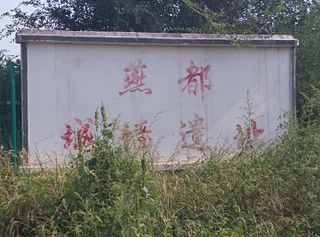
The Western Zhou Yan State Capital Museum is an archaeological museum in southwestern Beijing Municipality at the site of the capital of the ancient State of Yan during the Western Zhou dynasty. The site is located in Dongjialin Village, just north of Liulihe Township (琉璃河镇), in Fangshan District, 43 km (27 mi) south of Beijing's city centre. During the Western Zhou dynasty, over 3,000 years ago, the walled settlement at Liulihe, as the site is also known, served as the capital of the Yan, a vassal state of the Zhou dynasty. The discovery of the site in 1962 is considered to be one of the 100 major archaeological discoveries in China during the 20th century. Artifacts from the site including engraved bronze ware and chariots provide the earliest archaeological evidence of urban settlement in Beijing Municipality. The museum at the site, operated by the municipal government, opened in 1995.
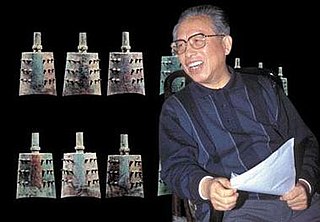
Ma Chengyuan was a Chinese archaeologist, epigrapher, and president of the Shanghai Museum. He was credited with saving priceless artifacts from destruction during the Cultural Revolution, and was instrumental in raising funds and support for the rebuilding of the Shanghai Museum. He was a recipient of the John D. Rockefeller III Award, and was awarded the Legion of Honour by French President Jacques Chirac.

The Changsha Museum is a history museum located at Beichen Delta in Kaifu District, Changsha, Hunan, China. It is adjacent to the Changsha Concert Hall, Changsha Planning Exhibition Hall and Changsha Library. It has a constructed area of 24,000 square metres (260,000 sq ft).

Yueyang Museum is a historical museum in Yueyang, Hunan, China. It covers a total area of 11,000-square-metre (2.7-acre) with a building area of 6,600-square-metre (1.6-acre). The museum has a collection of more than 20,000 objects, including 6 national first level protected cultural relics.

